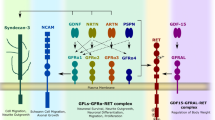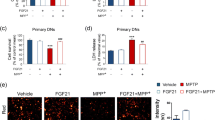Abstract
Fibroblast growth factor 2 (FGF-2) has a neurotrophic effect on dopaminergic neurons in vitro and in vivo, and exhibits beneficial effects in animal models of neurodegenerative disorders such as Parkinson’s disease (PD). The poor stability and short half-life of FGF-2, however, have hampered its clinical use for neurological diseases. In the present study, we modified native recombinant human FGF-2 (rhFGF-2) by covalently attaching polyethylene glycol (PEG) polymers, named PEGylation, to enhance its neuroprotection efficacy in 6-hydroxydopamine (6-OHDA)-induced model of PD. In vitro, PEG-rhFGF-2 performed better biostability in 6-OHDA-induced PC-12 cells than native rhFGF-2. The in vivo data showed that, compared with native rhFGF-2, PEGylated rhFGF-2 was more efficacious in preventing 6-OHDA-induced lesion upon tyrosine hydroxylase-positive neurons in the substantia nigra (SN), improving the apomorphine-induced rotational behavior and the 6-OHDA-induced decline in tissue concentration of dopamine (DA) and its metabolites. Importantly, our data showed that the superior pharmacological activity of PEGylated rhFGF-2 is probably due to its greater permeability through the blood–brain barrier and better in vivo stability compared to native rhFGF-2. The enhanced stability and bioavailability of PEGylated rhFGF-2 make this molecule a great therapeutic candidate for neurodegenerative diseases such as PD and mood disorders.






Similar content being viewed by others
References
Aarsland D, Pahlhagen S, Ballard CG, Ehrt U, Svenningsson P (2012) Depression in Parkinson disease—epidemiology, mechanisms and management. Nat Rev Neurol 8(1):35–47. doi:10.1038/nrneurol.2011.189
Schapira AH, Olanow CW (2004) Neuroprotection in Parkinson disease: Mysteries, myths, and misconceptions. JAMA 291(3):358–364. doi:10.1001/jama.291.3.358
Shrivastava P, Vaibhav K, Tabassum R, Khan A, Ishrat T, Khan MM, Ahmad A, Islam F, Safhi MM (2013) Anti-apoptotic and anti-inflammatory effect of Piperine on 6-OHDA induced Parkinson’s rat model. J Nutr Biochem 24(4):680–687. doi:10.1016/j.jnutbio.2012.03.018
Hardwick A, Ward H, Hassan A, Romrell J, Okun MS (2013) Clozapine as a potential treatment for refractory impulsive, compulsive, and punding behaviors in Parkinson’s disease. Neurocase 19(6):587–591. doi:10.1080/13554794.2012.713490
Litteljohn D, Hayley S (2012) Cytokines as potential biomarkers for Parkinson’s disease: a multiplex approach. Methods Mol Biol 934:121–144. doi:10.1007/978-1-62703-071-7_7
de Oliveira GP, Duobles T, Castelucci P, Chadi G (2010) Differential regulation of FGF-2 in neurons and reactive astrocytes of axotomized rat hypoglossal nucleus. A possible therapeutic target for neuroprotection in peripheral nerve pathology. Acta Histochem 112(6):604–617. doi:10.1016/j.acthis.2009.06.008
Rose K, Litterscheid S, Klumpp S, Krieglstein J (2009) Fibroblast growth factor 2 requires complex formation with ATP for neuroprotective activity. Neuroscience 164(4):1695–1700. doi:10.1016/j.neuroscience.2009.09.055
Ma YP, Ma MM, Cheng SM, Ma HH, Yi XM, Xu GL, Liu XF (2008) Intranasal bFGF-induced progenitor cell proliferation and neuroprotection after transient focal cerebral ischemia. Neurosci Lett 437(2):93–97. doi:10.1016/j.neulet.2008.04.003
Klejbor I, Myers JM, Hausknecht K, Corso TD, Gambino AS, Morys J, Maher PA, Hard R, Richards J, Stachowiak EK, Stachowiak MK (2006) Fibroblast growth factor receptor signaling affects development and function of dopamine neurons—Inhibition results in a schizophrenia-like syndrome in transgenic mice. J Neurochem 97(5):1243–1258. doi:10.1111/j.1471-4159.2006.03754.x
Kawamata T, Dietrich WD, Schallert T, Gotts JE, Cocke RR, Benowitz LI, Finklestein SP (1997) Intracisternal basic fibroblast growth factor enhances functional recovery and up-regulates the expression of a molecular marker of neuronal sprouting following focal cerebral infarction. Proc Natl Acad Sci U S A 94(15):8179–8184
Yoshimura S, Teramoto T, Whalen MJ, Irizarry MC, Takagi Y, Qiu J, Harada J, Waeber C, Breakefield XO, Moskowitz MA (2003) FGF-2 regulates neurogenesis and degeneration in the dentate gyrus after traumatic brain injury in mice. J Clin Invest 112(8):1202–1210. doi:10.1172/JCI16618
Liu Z, Holmes GL (1997) Basic fibroblast growth factor is highly neuroprotective against seizure-induced long-term behavioural deficits. Neuroscience 76(4):1129–1138
Jin K, LaFevre-Bernt M, Sun Y, Chen S, Gafni J, Crippen D, Logvinova A, Ross CA, Greenberg DA, Ellerby LM (2005) FGF-2 promotes neurogenesis and neuroprotection and prolongs survival in a transgenic mouse model of Huntington’s disease. Proc Natl Acad Sci U S A 102(50):18189–18194. doi:10.1073/pnas.0506375102
Drinkut A, Tereshchenko Y, Schulz JB, Bahr M, Kugler S (2012) Efficient gene therapy for Parkinson’s disease using astrocytes as hosts for localized neurotrophic factor delivery. Mol Ther J Am Soc Gene Ther 20(3):534–543. doi:10.1038/mt.2011.249
Jevsevar S, Kunstelj M, Porekar VG (2010) PEGylation of therapeutic proteins. Biotechnol J 5(1):113–128. doi:10.1002/biot.200900218
Huang Z, Ye C, Liu Z, Wang X, Chen H, Liu Y, Tang L, Zhao H, Wang J, Feng W, Li X (2012) Solid-phase N-terminus PEGylation of recombinant human fibroblast growth factor 2 on heparin-sepharose column. Bioconjug Chem 23(4):740–750. doi:10.1021/bc200550f
Wang Z, Zhang H, Xu X, Shi H, Yu X, Wang X, Yan Y, Fu X, Hu H, Li X, Xiao J (2012) bFGF inhibits ER stress induced by ischemic oxidative injury via activation of the PI3K/Akt and ERK1/2 pathways. Toxicol Lett 212(2):137–146. doi:10.1016/j.toxlet.2012.05.006
Hashitani T, Mizukawa K, Kumazaki M, Nishino H (1998) Dopamine metabolism in the striatum of hemiparkinsonian model rats with dopaminergic grafts. Neurosci Res 30(1):43–52
Han B, Hu J, Shen J, Gao Y, Lu Y, Wang T (2013) Neuroprotective effect of hydroxysafflor yellow A on 6-hydroxydopamine-induced Parkinson’s disease in rats. Eur J Pharmacol 714(1–3):83–88. doi:10.1016/j.ejphar.2013.06.011
Soslow RA, Dannenberg AJ, Rush D, Woerner BM, Khan KN, Masferrer J, Koki AT (2000) COX-2 is expressed in human pulmonary, colonic, and mammary tumors. Cancer 89(12):2637–2645
Zhang HY, Zhang X, Wang ZG, Shi HX, Wu FZ, Lin BB, Xu XL, Wang XJ, Fu XB, Li ZY, Shen CJ, Li XK, Xiao J (2013) Exogenous basic fibroblast growth factor inhibits ER stress-induced apoptosis and improves recovery from spinal cord injury. CNS Neuroscience & Therapeutics 19(1):20–29. doi:10.1111/cns.12013
Yang F, Yang YP, Mao CJ, Cao BY, Cai ZL, Shi JJ, Huang JZ, Zhang P, Liu CF (2009) Role of autophagy and proteasome degradation pathways in apoptosis of PC12 cells overexpressing human alpha-synuclein. Neurosci Lett 454(3):203–208. doi:10.1016/j.neulet.2009.03.027
Huang Z, Zheng Q, Wu X, Su Z, Xu H, Tan Y, Feng W, Li X, Cai L (2007) Enhanced protection of modified human acidic fibroblast growth factor with polyethylene glycol against ischemia/reperfusion-induced retinal damage in rats. Toxicol Lett 170(2):146–156. doi:10.1016/j.toxlet.2007.03.001
Gonzalez AM, Berry M, Maher PA, Logan A, Baird A (1995) A comprehensive analysis of the distribution of FGF-2 and FGFR1 in the rat brain. Brain Res 701(1–2):201–226
Yoshimura S, Takagi Y, Harada J, Teramoto T, Thomas SS, Waeber C, Bakowska JC, Breakefield XO, Moskowitz MA (2001) FGF-2 regulation of neurogenesis in adult hippocampus after brain injury. Proc Natl Acad Sci U S A 98(10):5874–5879. doi:10.1073/pnas.101034998
Date I, Yoshimoto Y, Imaoka T, Miyoshi Y, Gohda Y, Furuta T, Asari S, Ohmoto T (1993) Enhanced recovery of the nigrostriatal dopaminergic system in MPTP-treated mice following intrastriatal injection of basic fibroblast growth factor in relation to aging. Brain Res 621(1):150–154
Young CK, Koke SJ, Kiss ZH, Bland BH (2009) Deep brain stimulation of the posterior hypothalamic nucleus reverses akinesia in bilaterally 6-hydroxydopamine-lesioned rats. Neuroscience 162(1):1–4. doi:10.1016/j.neuroscience.2009.04.053
Epstein SE, Fuchs S, Zhou YF, Baffour R, Kornowski R (2001) Therapeutic interventions for enhancing collateral development by administration of growth factors: basic principles, early results and potential hazards. Cardiovasc Res 49(3):532–542
Hu J, Duppatla V, Harth S, Schmitz W, Sebald W (2010) Site-specific PEGylation of bone morphogenetic protein-2 cysteine analogues. Bioconjug Chem 21(10):1762–1772. doi:10.1021/bc9005706
Teismann P, Schulz JB (2004) Cellular pathology of Parkinson’s disease: astrocytes, microglia and inflammation. Cell Tissue Res 318(1):149–161. doi:10.1007/s00441-004-0944-0
Tatton WG, Chalmers-Redman R, Brown D, Tatton N (2003) Apoptosis in Parkinson’s disease: Signals for neuronal degradation. Ann Neurol 53(Suppl 3):S61–S70. doi:10.1002/ana.10489, discussion S70-62
Miho Y, Kouroku Y, Fujita E, Mukasa T, Urase K, Kasahara T, Isoai A, Momoi MY, Momoi T (1999) bFGF inhibits the activation of caspase-3 and apoptosis of P19 embryonal carcinoma cells during neuronal differentiation. Cell Death Differ 6(5):463–470. doi:10.1038/sj.cdd.4400506
Abbott NJ, Patabendige AA, Dolman DE, Yusof SR, Begley DJ (2010) Structure and function of the blood–brain barrier. Neurobiol Dis 37(1):13–25. doi:10.1016/j.nbd.2009.07.030
Liu Y, Li J, Shao K, Huang R, Ye L, Lou J, Jiang C (2010) A leptin derived 30-amino-acid peptide modified pegylated poly-L-lysine dendrigraft for brain targeted gene delivery. Biomaterials 31(19):5246–5257. doi:10.1016/j.biomaterials.2010.03.011
Acknowledgments
The authors are thankful to Dr. Regina Goetz and Moosa Mohammadi for critically reading the manuscript and making thoughtful suggestions. This work was supported, in part, by grants from Natural Science Foundation of China, 81102486, 81010012 (to Z.H. and X.L.); Zhejiang Key Group Project in Scientific Innovation 2010R10042-01 (to Z.H.); Ningbo Natural Science Foundation (2013A610272 to C.Y.).
Author information
Authors and Affiliations
Corresponding authors
Additional information
Guanghui Zhu, Ganping Chen, Lu Shi, and Jenny Feng contributed equally to this work.
Rights and permissions
About this article
Cite this article
Zhu, G., Chen, G., Shi, L. et al. PEGylated rhFGF-2 Conveys Long-term Neuroprotection and Improves Neuronal Function in a Rat Model of Parkinson’s Disease. Mol Neurobiol 51, 32–42 (2015). https://doi.org/10.1007/s12035-014-8750-5
Received:
Accepted:
Published:
Issue Date:
DOI: https://doi.org/10.1007/s12035-014-8750-5




